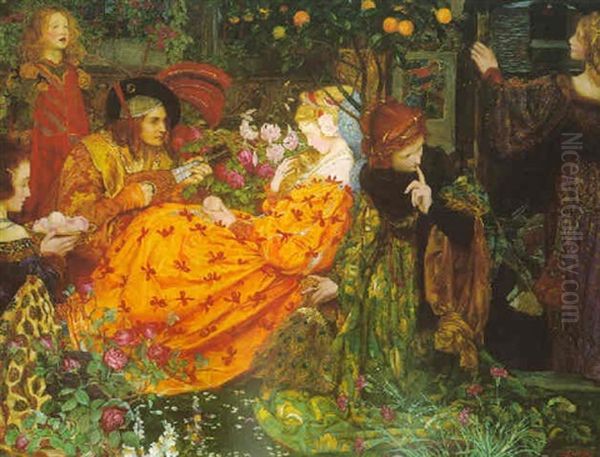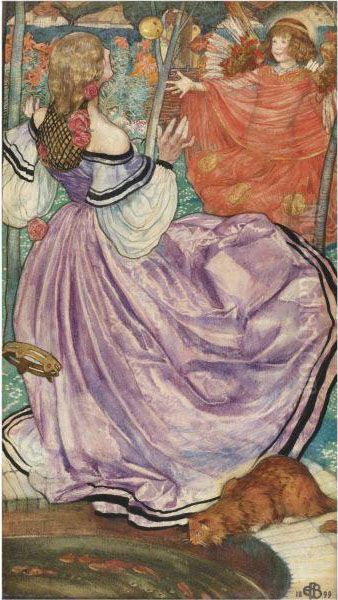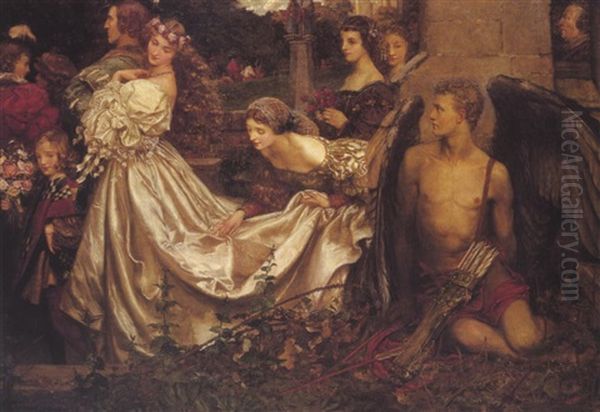Eleanor Fortescue-Brickdale stands as a significant, if sometimes overlooked, figure in the landscape of British art at the turn of the 20th century. A painter, illustrator, and designer of stained glass, she navigated the shifting artistic currents of her time, carrying the torch of Pre-Raphaelitism into a new era while imbuing it with her distinct vision. Her work, characterized by meticulous detail, vibrant colour, and a deep engagement with literary, mythological, and religious themes, offers a fascinating window into the artistic sensibilities of late Victorian and Edwardian England.
Early Life and Artistic Awakening
Born on January 25, 1872, in Upper Norwood, South London, Mary Eleanor Fortescue-Brickdale, often known simply as Eleanor, was the daughter of Matthew Inglett Fortescue-Brickdale, a successful barrister, and Sarah Anna Lloyd. Her family's comfortable financial standing and supportive environment provided a fertile ground for her burgeoning artistic talents. The family later moved to a country estate, and this immersion in the English countryside likely contributed to the romantic and often pastoral elements found in her later work.
From a young age, Eleanor displayed a remarkable aptitude for drawing and a keen imagination. Her formal artistic training began in the 1870s at the Crystal Palace School of Art, a notable institution that provided practical art education. This early schooling would have exposed her to a range of artistic disciplines and techniques, laying a solid foundation for her future endeavors. It was an environment where the legacy of the Great Exhibition still lingered, fostering an appreciation for craftsmanship and design alongside fine art.
The Royal Academy Schools and Emergence

Eleanor's ambition and talent led her to seek admission to the prestigious Royal Academy Schools. After an initial unsuccessful attempt, she was accepted in 1897, a significant achievement for a woman at that time, as the RA was still largely a male bastion. Here, she honed her skills in draughtsmanship and painting, immersing herself in an academic tradition that, while conservative, still provided rigorous training. She was a contemporary of other aspiring artists, though the RA schools were not yet as welcoming to women as some other institutions like the Slade School of Fine Art, which had already produced notable female artists like Evelyn De Morgan.
Her debut at the Royal Academy's annual exhibition came in 1896 with a black and white design, showcasing her early proficiency in graphic work. However, it was her oil paintings that began to attract more significant attention. In 1899, she exhibited "The Pale Face of True Love," a work that hinted at the romantic and narrative preoccupations that would define much of her career. This period marked her emergence as a promising young artist, one who was clearly influenced by the enduring appeal of the Pre-Raphaelite Brotherhood.
The Pre-Raphaelite Mantle and Neo-Pre-Raphaelitism
By the time Fortescue-Brickdale was establishing her career, the original Pre-Raphaelite Brotherhood – founded in 1848 by Dante Gabriel Rossetti, William Holman Hunt, and John Everett Millais – had long since disbanded. However, their ideals of truth to nature, meticulous detail, luminous colour, and engagement with serious literary and moral themes continued to resonate. A second wave of artists, including Edward Burne-Jones and William Morris, had carried these principles forward, adapting them to their own sensibilities.
Fortescue-Brickdale, along with her close friend and contemporary John Byam Liston Shaw, became a leading figure in what is often termed Neo-Pre-Raphaelitism or "the last romantics." They embraced the rich colours, detailed execution, and narrative complexity of their predecessors. Her visit to Italy, where she studied the works of the 15th and 16th-century Italian masters – the very artists who had inspired the original Pre-Raphaelites – further solidified her stylistic direction. She admired the clarity, emotional intensity, and spiritual depth of artists like Fra Angelico and Botticelli. Her work often shares the jewel-like palette and intricate compositions seen in the paintings of Rossetti and the early Millais.
Her commitment to this style was evident in her technique. She often worked on a gesso-prepared panel, applying paint in thin, luminous glazes, much like the early Renaissance painters and the first generation of Pre-Raphaelites. This method contributed to the brilliance and clarity of her colours and the smooth, detailed finish of her surfaces.
A Flourishing Illustrator: Bringing Literature to Life

The late 19th and early 20th centuries were a golden age for book illustration, and Fortescue-Brickdale excelled in this field. Her deep appreciation for literature, combined with her narrative skill and meticulous technique, made her a sought-after illustrator. Her illustrations were not mere accompaniments to the text but rather visual interpretations that added new layers of meaning and emotional resonance.
One of her most celebrated achievements in illustration was the series of 28 full-colour plates for Alfred, Lord Tennyson's Idylls of the King, published in 1911. These works are masterpieces of romantic imagery, capturing the chivalry, tragedy, and mystical atmosphere of Arthurian legend. Each plate is a carefully composed scene, rich in symbolic detail and evocative colour, demonstrating her profound understanding of Tennyson's poetry. Her depictions of Guinevere, Lancelot, Elaine, and Arthur are both iconic and deeply personal.
She also provided illustrations for two volumes of Robert Browning's poems (1908 and 1909), demonstrating her versatility in interpreting different poetic voices. Her work for A Book of Old English Songs and Ballads (1915) further showcased her affinity for historical and romantic themes, with images like "A Knight Holding a Child" evoking a sense of timeless tenderness and chivalric virtue. Her illustrative style, while distinct, can be seen in the context of other great illustrators of the period, such as Arthur Rackham and Edmund Dulac, who also brought fantasy and legend to life with their intricate and imaginative designs, though Fortescue-Brickdale's work often carried a more pronounced moral or spiritual weight.
Masterpieces in Oil and Watercolour: Narrative and Allegory
Beyond her illustrations, Fortescue-Brickdale produced a significant body of independent paintings in both oil and watercolour, many of which explored complex allegorical, moral, and literary themes.
"The Deceitfulness of Riches" (1901) is a powerful allegorical work. It depicts a richly dressed young man, symbolizing worldly wealth, being led away from a path of spiritual enlightenment (represented by a humble monk and a crucifix) by a seductive female figure personifying worldly temptation. The painting is a moral commentary on the spiritual dangers of materialism, a theme that resonated in an era of rapid industrialization and accumulating wealth. Its detailed symbolism and vibrant colours are characteristic of her Pre-Raphaelite leanings.
"The Gilded Apple" (1899) is another allegorical piece, likely referencing the myth of the Judgement of Paris or the story of Atalanta, where a golden apple symbolizes temptation, discord, or a coveted prize. Such works allowed her to explore complex human emotions and moral dilemmas through visually rich narratives.

"The Little Foot Page" (c. 1897-1900), inspired by a Scottish ballad, tells a story of love, loyalty, and disguise. It depicts a lady who, disguised as a page, follows her knight to war. The painting captures a moment of tender intimacy and quiet heroism, highlighting themes of female devotion and courage.
Her watercolour "Isabella and the Pot of Basil" (1898), based on John Keats's poem, is a subject famously tackled by earlier Pre-Raphaelites like William Holman Hunt and John Everett Millais. Fortescue-Brickdale’s interpretation focuses on Isabella's mournful devotion to the pot containing her murdered lover's head, rendered with delicate pathos and rich, sombre colours.
"Merlin Finds the Baby Arthur," another Arthurian subject, showcases her ability to capture moments of magic and destiny. Her treatment of such legendary themes was always imbued with a sense of wonder and a deep respect for the source material. "The Lady of Shalott," another iconic Tennysonian subject she painted (e.g., a version around 1905), allowed her to explore themes of cursed isolation and tragic love, a favorite among Pre-Raphaelite artists.
Beyond the Canvas: Stained Glass and Other Ventures
Fortescue-Brickdale's artistic talents were not confined to painting and illustration. She also designed stained glass, a medium that had undergone a significant revival in the 19th century, partly due to the efforts of William Morris and his firm, Morris & Co. Her stained glass work, such as the windows she designed for Bristol Cathedral, demonstrates her strong sense of design, her understanding of how light interacts with colour, and her ability to adapt her narrative style to this demanding medium. The rich, jewel-like colours inherent in stained glass were a natural fit for her Pre-Raphaelite aesthetic.
While less documented, it is mentioned she also engaged in small sculptural works, indicating a broader interest in three-dimensional form and the Arts and Crafts ethos of artistic versatility. This aligns with the spirit of artists like Walter Crane, who also worked across multiple disciplines, from painting and illustration to design.
Themes, Symbolism, and Moral Undertones
A common thread running through Fortescue-Brickdale's diverse output is her preoccupation with strong narrative content, often drawn from literature (especially Tennyson, Browning, Shakespeare, and medieval romances), mythology, and the Bible. Her works are rarely just decorative; they are imbued with symbolism and often carry a moral or spiritual message.
Chivalry, romantic love, sacrifice, temptation, and redemption are recurring themes. Her figures are often depicted in moments of intense emotion or moral crisis. She had a particular ability to convey character and psychological states through gesture, facial expression, and the careful arrangement of symbolic details within the composition. For instance, flowers often carry specific meanings in her work, a practice common in Victorian art known as floriography.
Her depiction of women is noteworthy. While often set within traditional romantic or religious narratives, her female figures are frequently portrayed with strength, agency, and deep emotional capacity, whether as tragic heroines, devoted lovers, or figures of spiritual wisdom. This can be seen as a subtle reflection of the changing roles and perceptions of women in the early 20th century.
A Woman in a Man's Art World: Achievements and Context
Eleanor Fortescue-Brickdale achieved considerable success in a field still largely dominated by men. Her election as an Associate of the Royal Watercolour Society (ARWS) in 1902, and later as a full member (RWS) in 1919, was a significant recognition of her talent. She was also the first woman to teach at the Byam Shaw School of Art, founded by her friend John Byam Shaw in 1910. This position allowed her to influence a new generation of artists.
Her career unfolded during a period of increasing opportunities for women artists, yet significant barriers remained. Artists like Elizabeth Thompson (Lady Butler) had earlier achieved fame with large-scale history paintings, and Kate Greenaway had become a household name through her charming illustrations. Fortescue-Brickdale's success built upon the paths forged by such predecessors. Her ability to secure prestigious commissions and exhibit regularly at major venues like the Royal Academy and the Dowdeswell Galleries (where she had a successful solo show of 45 watercolours in 1901 titled "Such Stuff as Dreams are Made Of") attests to her skill and determination.
Her work can also be seen in the context of other female artists who engaged with Pre-Raphaelite or Symbolist aesthetics, such as Evelyn De Morgan, whose allegorical paintings often explored spiritual and feminist themes, or Marie Spartali Stillman, who was closely associated with the second generation of Pre-Raphaelites. While Fortescue-Brickdale's work might not have overtly challenged societal norms in the way some of her contemporaries did, her professional success and dedication to her craft were in themselves a statement.
Exhibitions, Reception, and Later Years
Fortescue-Brickdale enjoyed considerable popularity during the early decades of the 20th century. Her exhibitions were generally well-received, and her illustrations reached a wide audience. Critics praised her technical skill, her imaginative power, and the sincerity of her vision. Her painting "The Guardian Angel" (1910) was noted for its successful blend of traditional style with a certain modern sensibility in its emotional directness.
During World War I, like many artists, she contributed to the war effort, including selling works to raise funds for the Red Cross. This patriotic engagement was typical of the era. However, as artistic tastes began to shift dramatically in the post-war period towards Modernism – with movements like Cubism, Futurism, and Surrealism gaining ascendancy – the romantic, narrative style of artists like Fortescue-Brickdale began to seem increasingly old-fashioned to the avant-garde.
While she continued to work and exhibit, her art fell somewhat out of critical favour as the 20th century progressed. This was a common fate for many artists working in more traditional modes. She passed away in London on March 10, 1945, at the age of 73.
Rediscovery and Enduring Legacy
For several decades after her death, Eleanor Fortescue-Brickdale, like many Victorian and Edwardian artists, was largely overlooked by mainstream art history, which tended to focus on the narrative of Modernist progression. However, a renewed appreciation for 19th and early 20th-century representational art began to emerge in the 1970s.
Her first major retrospective exhibition was held only in 1985, forty years after her death, marking a significant step in the reassessment of her work. More recently, exhibitions such as the one held at the Lady Lever Art Gallery in 2012, which brought together a substantial collection of her works spanning from 1898 to 1934, have further solidified her reputation and introduced her art to new audiences.
Today, Eleanor Fortescue-Brickdale is recognized as one of the most accomplished female artists of her generation and a key figure in the late flowering of the Pre-Raphaelite tradition. Her paintings and illustrations are admired for their technical brilliance, their imaginative depth, and their heartfelt engagement with enduring human themes. Her ability to create luminous, dreamlike worlds, rich in detail and emotion, continues to captivate viewers. She stands as a testament to the enduring power of narrative art and the distinctive contribution of women artists to the cultural fabric of their time, a contemporary of artists like Annie Swynnerton and Laura Knight who also broke barriers for women in the British art establishment.
Her legacy is that of an artist who remained true to her own vision, even as artistic fashions changed around her. She skillfully blended the meticulous craftsmanship and romantic idealism of the Pre-Raphaelites with her own unique sensibility, creating a body of work that is both a product of its time and timeless in its appeal. Her art serves as a vibrant link between the rich traditions of 19th-century British painting and the evolving artistic landscape of the early 20th century, ensuring her a lasting place in the annals of art history.